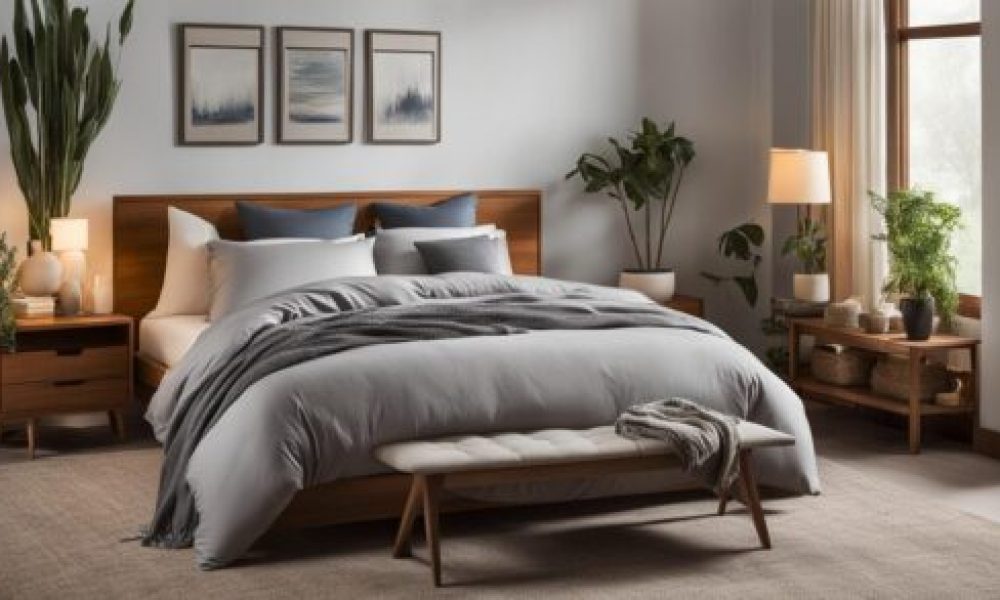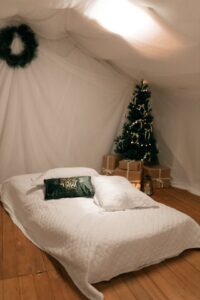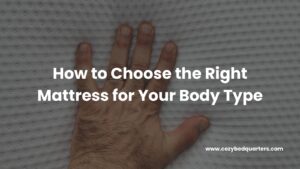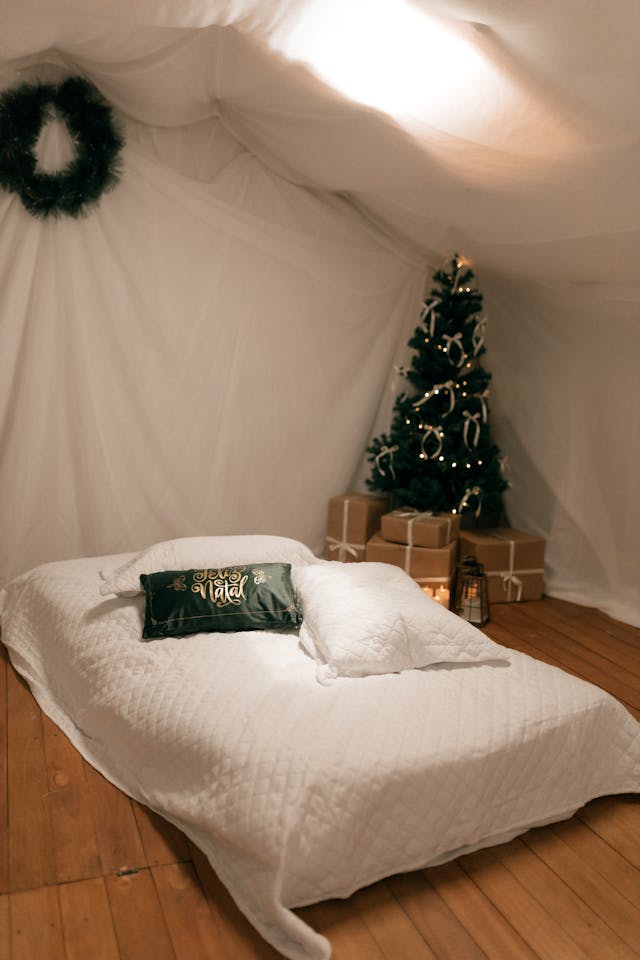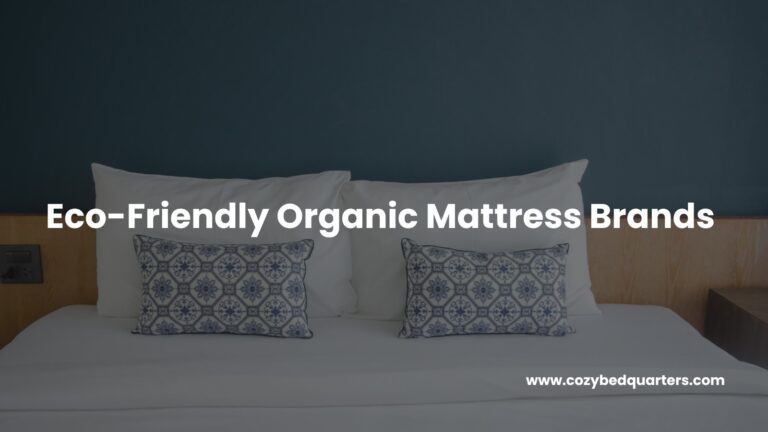Choosing the Right Bedding Mattress and Hygiene for Restful Sleep
Choosing the Right Bedding Mattress and Hygiene is the fastest way to sleep deeper and wake up refreshed. In this friendly guide, you’ll learn how the right mattress type, breathable bedding, and simple cleaning routines create a healthier, cozier sleep space—so small changes tonight add up to brighter mornings.
Key Takeaways: Choosing the Right Bedding Mattress and Hygiene
- Supportive mattresses and breathable, hypoallergenic bedding work together to improve sleep quality and reduce allergens.
- Firmness should match sleep position; side sleepers need more cushioning, while back and stomach sleepers need more support.
- Weekly sheet washing at 130°F (54°C) and routine mattress care keep dust mites and odors in check.
- Certifications like GOTS and OEKO-TEX help you choose safer, more sustainable bedding.
- Choosing the Right Bedding Mattress and Hygiene pays off with better comfort, cleanliness, and long-term durability.
Why Your Bedding and Mattress Matter
Your bed shapes one-third of your life, so comfort and cleanliness matter. A supportive mattress aligns your spine and reduces pressure points, while breathable sheets and pillowcases help regulate temperature and limit exposure to dust mites and bacteria.
To dial in fit and comfort, start with the right size. Our guide to mattress dimensions explains how length, width, and room layout impact sleep quality and bedding fit: Mattress Sizes: The Complete Guide to Choosing the Right Fit.
Materials matter, too. Organic bedding, sustainable bedding, and eco-conscious sheets improve airflow and are gentle on sensitive skin. The result is a bedroom that feels cleaner, cooler, and calmer every night.
Mattress 101: Finding Your Perfect Fit
Explore Mattress Types
Answer first: Each mattress type balances pressure relief, support, and airflow differently, so match the material to your body and sleep style.
- Foam: Excellent pressure relief for sore backs and joints; great motion isolation for couples.
- Innerspring: Bouncy, breathable, and supportive; ideal if you prefer a classic feel and strong edges.
- Hybrid: Combines coils for support with foam or latex for comfort—versatile for mixed sleepers.
- Latex: Naturally resilient, breathable, and durable; a favorite for those seeking sustainable bedding.
Want a deeper dive into cooling performance? See our guide to temperature control in bedding: Temperature-Regulating Bedding: Sleeping Cool and Comfortable.
Pick the Right Firmness
Answer first: Firmness should match sleeping position and body type to maintain neutral spinal alignment.
- Side sleepers: Plush to medium to cushion shoulders and hips.
- Back sleepers: Medium-firm for balanced alignment and gentle lumbar support.
- Stomach sleepers: Firm to prevent the lower back from arching.
For more guidance, see the expert breakdown from Sleep Foundation: How to Choose a Mattress.
Keep It Clean
Answer first: A simple routine protects your investment and reduces allergens. Use a waterproof protector, spot clean promptly, and schedule regular maintenance.
- Vacuum your mattress monthly to remove dust and skin cells.
- Neutralize odors with a light sprinkle of baking soda before vacuuming.
- Air out the mattress by stripping bedding for a few hours.
- Follow care tags for toppers and protectors to avoid damage.
Bookmark these resources for practical step-by-step care: Sleep Foundation: Mattress Care and Sleep Foundation: How to Clean a Mattress. For Cozy Bed Quarters’ hands-on tutorials, see Mattress Hygiene: How to Keep Your Bed Fresh and Clean.
Bedding Tips for a Cleaner, Cozier Sleep
Choose Smart Materials
Answer first: Natural fibers breathe better, wash well, and are gentler on skin, making them ideal for a fresh, low-irritant sleep environment.
- Cotton (percale or sateen): Soft, durable, and easy to launder; organic options support sensitive skin.
- Linen: Exceptionally breathable for hot sleepers and becomes softer with time.
- Bamboo-derived viscose: Smooth and moisture-wicking; look for safety certifications where possible.
Compare common fabrics with Parachute’s overview: Fabric & Bedding Materials Guide. For Cozy Bed Quarters picks, see Best Bedding Material to Enhance Your Sleep and Organic Bedding Benefits: 7 Surprising Reasons.
Wash Regularly
Answer first: Consistency is everything—weekly washes and the right water temperature keep allergens down and fabrics fresh.
- Sheets & pillowcases: Weekly, using fabric-safe settings.
- Duvet covers: Every 1–2 weeks.
- Mattress protectors: Monthly or as needed.
- Pillows: Every 3–6 months (check the label).
Mayo Clinic recommends washing bedding in water at least 130°F (54°C) to reduce dust mites: Dust Mite Allergy: Treatment. For step-by-step laundry schedules and stain tips, see Better Homes & Gardens: How Often Should You Wash Your Sheets?. And for Cozy’s stain-fighting approach, try Clean Mattress with Baking Soda: Easy 5-Step Odor Reset.
Busting the 8-Year Mattress Myth
There’s no universal expiration date. Material quality, sleeper weight, usage, and care determine longevity. Typical ranges are 7–8 years for innerspring, 8–10 years for memory foam and hybrids, and 10–12+ years for latex. If you wake with new aches, find visible sagging, or notice worsening allergies, it’s time to reassess.
Not ready to replace? A topper can add short-term comfort, but it won’t fix deep sags. A better approach is to revisit firmness and support needs, then choose a new mattress when symptoms persist. For fundamentals, review Sleep Foundation’s mattress selection guide.
Eco-Friendly vs. Conventional Bedding: What’s the Real Difference?
Eco-friendly textiles reduce chemicals during production, emphasize lower emissions, and often last longer. Conventional blends can feel soft initially but may trap heat and break down faster. If you tend to sleep warm or have sensitive skin, eco-conscious sheets made from organic cotton or linen can make nights more comfortable.
Look for trusted labels to cut through marketing. GOTS (Global Organic Textile Standard) certifies organic fiber content and responsible processing. OEKO-TEX Standard 100 screens for certain harmful substances. Sleep Foundation’s product guides often explain what these labels mean in plain language: Best Organic Sheets and Best Organic Mattresses.
Bottom line: if sustainability and skin comfort are priorities, eco-friendly options usually offer better breathability, fewer irritants, and clearer transparency about materials—without sacrificing durability.
Buyer’s Guide: Certifications You Can Trust
How to Read the Labels
Answer first: Certifications aren’t all the same—use them as filters, not guarantees of comfort.
- GOTS: Confirms organic fiber content and responsible processing across the supply chain.
- OEKO-TEX Standard 100: Screens textiles for specific harmful substances; common on sheets and duvet covers.
- GREENGUARD Gold: Limits chemical emissions for indoor air quality (often used on mattresses and furniture).
For examples and plain-English context, see Sleep Foundation’s explainers within their best-of guides: Best Duvet Covers and Best Sheets.
Practical Setups That Make Every Night Easier
Layer for Comfort and Cleanliness
Answer first: Build your bed in layers—protector, breathable sheets, and a season-appropriate duvet—to simplify washing and boost comfort.
- Start with a waterproof but breathable protector to block sweat and spills.
- Choose percale for a crisp, cool feel or sateen for buttery smoothness.
- Switch to linen in hotter months for extra airflow.
Learn more with Cozy’s deep dive on materials and feel: Ideal Thread Count Explained and Bedding and Allergies: What to Know.
FAQ
- How often should I wash my sheets?
- Wash sheets and pillowcases weekly; consider every 3–4 days if you have allergies or sleep hot. When fabric allows, hotter water improves hygiene.
- Do I really need a mattress protector?
- Yes. It shields the mattress from sweat and spills, extends lifespan, and simplifies cleaning—essential for Choosing the Right Bedding Mattress and Hygiene.
- Which bedding materials are best for sensitive skin?
- Organic cotton, linen, and some bamboo-derived fabrics are breathable and gentle. Look for certifications such as OEKO-TEX and GOTS for added peace of mind.
- What temperature should I use to reduce allergens?
- When care labels allow, wash in water at or above 130°F (54°C) to help reduce dust mites, then dry thoroughly.
Final Thoughts
Choosing the Right Bedding Mattress and Hygiene isn’t complicated—it’s a set of small, consistent habits. Match mattress firmness to your sleeping position, favor breathable fibers, and stick to a simple cleaning routine. When you’re ready to go deeper, browse Cozy Bed Quarters for more tips and tutorials that make comfort effortless.
Keep exploring: Temperature-Regulating Bedding · Ideal Thread Count · Mattress Hygiene
Related Reading
- Best Bedding Material to Enhance Your Sleep
- Organic Bedding Benefits: 7 Surprising Reasons
- Mattress Sizes: The Complete Guide
- Sleep Foundation: How to Choose a Mattress
- Mayo Clinic: Dust Mite Allergy Treatment
- Better Homes & Gardens: How Often to Wash Sheets

